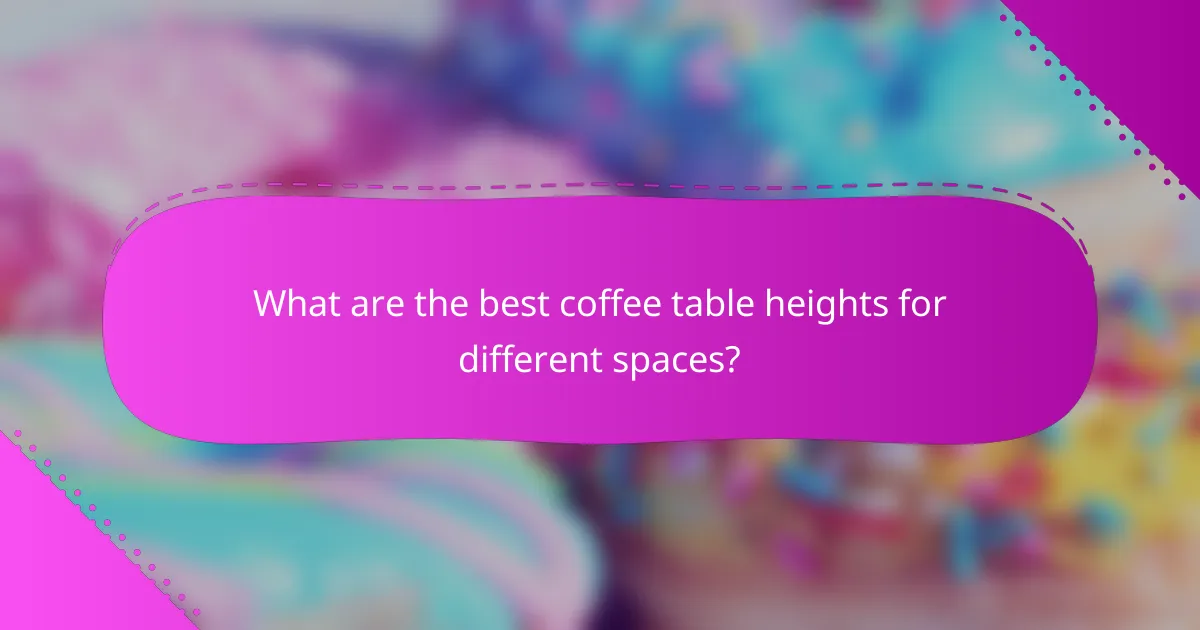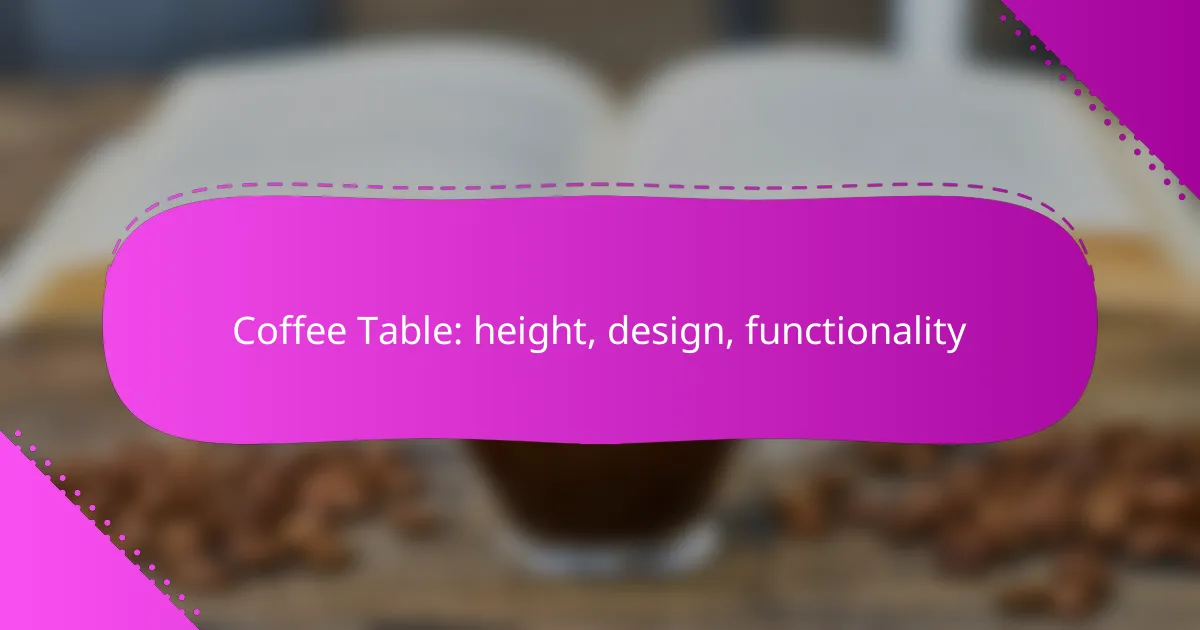A coffee table serves as a central piece in living areas, blending height, design, and functionality to enhance your space. Ideally, it should match the height of your seating for optimal usability, while its design can dictate its versatility and aesthetic appeal. Selecting the right materials, such as wood, glass, or metal, further influences both the table’s durability and style, making it an essential consideration in your home decor.

What are the best coffee table heights for different spaces?
The best coffee table heights vary depending on the surrounding furniture and intended use. Generally, a coffee table should be about the same height as the seat of your sofa or chairs, allowing for comfortable access and usability.
Standard height: 16-18 inches
Standard coffee tables typically range from 16 to 18 inches in height. This height is ideal for most living room setups, as it aligns well with the seat height of standard sofas and chairs, which usually fall between 18 to 20 inches. This allows for easy reach for drinks, snacks, and books.
When choosing a standard height coffee table, consider the overall design of your seating area. A table that is too low may disrupt the flow of the space, while one that is too high can make it uncomfortable to use.
Counter height: 24-26 inches
Counter height coffee tables, measuring between 24 and 26 inches, are suitable for spaces with higher seating, such as bar stools or counter-height chairs. These tables work well in casual dining areas or open-concept layouts where the kitchen and living space merge.
When selecting a counter height table, ensure that it complements the seating height. A good rule of thumb is to have about 10 to 12 inches of space between the table surface and the seat of the chairs or stools for comfortable legroom.
Adjustable height options
Adjustable height coffee tables offer flexibility, allowing you to modify the table’s height to suit various activities, from dining to casual lounging. These tables can typically range from standard to counter height, making them versatile for different settings.
When considering an adjustable height table, look for models with sturdy mechanisms that can easily lock into place. This ensures stability during use. Additionally, check the design to ensure it fits well with your existing furniture style and does not compromise aesthetics for functionality.

How does coffee table design impact functionality?
The design of a coffee table significantly influences its functionality by determining how well it fits into a space and serves multiple purposes. A well-thought-out design can enhance usability, storage, and aesthetic appeal, making it a central piece in living areas.
Minimalist designs for small spaces
Minimalist coffee table designs are ideal for small spaces as they prioritize simplicity and space efficiency. These tables often feature clean lines and a lack of bulky ornamentation, allowing them to blend seamlessly into compact environments.
When selecting a minimalist coffee table, consider options that are low-profile and lightweight, making them easy to move. Look for designs that use materials like glass or thin metal to create an airy feel, which can visually expand the space.
Storage solutions in coffee table designs
Incorporating storage solutions into coffee table designs can maximize functionality, especially in smaller living areas. Many coffee tables now come with built-in drawers, shelves, or compartments to keep items organized and out of sight.
When choosing a coffee table with storage, assess your needs for organization. For instance, a table with a lift-top can provide hidden storage while serving as a workspace or dining surface, making it a versatile choice.
Multi-functional coffee tables
Multi-functional coffee tables serve various purposes beyond just holding drinks and snacks. They can transform into dining tables, desks, or even beds, making them perfect for versatile living spaces.
Look for features like extendable surfaces or convertible designs that can adapt to different activities. This flexibility is particularly beneficial in urban settings where space is limited, allowing you to maximize the utility of your furniture.

What materials are popular for coffee tables?
Popular materials for coffee tables include wood, glass, and metal, each offering unique benefits and styles. Choosing the right material depends on your aesthetic preferences, desired durability, and functionality needs.
Wood coffee tables: durability and aesthetics
Wood coffee tables are known for their durability and timeless appeal. They can range from solid hardwoods, like oak and walnut, to more affordable options like plywood or particleboard.
When selecting a wooden coffee table, consider the finish and grain pattern, as these can significantly impact the overall look of your living space. A well-crafted wood table can last for many years with proper care.
Glass coffee tables: modern appeal
Glass coffee tables offer a sleek, modern aesthetic that can make a room feel more open and airy. They often feature metal or wooden bases, providing stability while showcasing the transparency of the glass.
While glass tables can be stylish, they may require more maintenance to keep them free of fingerprints and smudges. It’s advisable to choose tempered glass for added safety and durability.
Metal coffee tables: industrial style
Metal coffee tables are popular for their industrial style and robustness. Common materials include stainless steel, wrought iron, and aluminum, each providing a unique look and feel.
These tables are often easy to clean and resistant to wear and tear, making them a practical choice for high-traffic areas. Consider pairing a metal table with softer furnishings to create a balanced aesthetic in your living space.

How to choose the right coffee table for your living room?
Choosing the right coffee table involves considering its height, design, and functionality to ensure it complements your living space. A well-selected coffee table can enhance the room’s aesthetic while serving practical purposes.
Consider room size and layout
Start by measuring your living room to determine the appropriate size for your coffee table. Ideally, the table should be about two-thirds the length of your sofa and positioned 14 to 18 inches away from seating for easy access.
In smaller rooms, opt for a round or oval table to save space and improve flow. For larger areas, a rectangular or square table can create a more defined gathering spot.
Match style with existing furniture
Your coffee table should harmonize with the style of your existing furniture. If your decor is modern, consider sleek designs with metal or glass. For a more traditional look, wooden tables with intricate details may be more suitable.
Pay attention to color and texture as well. A table that contrasts with your sofa can create visual interest, while a matching piece can provide a cohesive look.
Evaluate functionality needs
Think about how you plan to use your coffee table. If you entertain often, a larger table with storage options can be beneficial for holding snacks or drinks. Alternatively, a smaller table may suffice for casual use.
Consider additional features such as lift-top designs for extra storage or nesting tables that can be easily moved around. These options can enhance the table’s functionality while adapting to your lifestyle.

What are the trends in coffee table designs for 2024?
In 2024, coffee table designs are focusing on sustainability, technology integration, and vibrant aesthetics. These trends reflect a growing consumer preference for eco-friendly materials, smart features, and bold visual statements in home decor.
Sustainable materials gaining popularity
Sustainable materials are becoming a key focus in coffee table designs, with manufacturers increasingly using reclaimed wood, bamboo, and recycled metals. These materials not only reduce environmental impact but also add unique character to each piece.
When selecting a sustainable coffee table, look for certifications such as FSC (Forest Stewardship Council) to ensure responsible sourcing. Additionally, consider the durability of these materials, as long-lasting options can provide better value over time.
Smart coffee tables with technology integration
Smart coffee tables are on the rise, featuring integrated technology such as wireless charging, Bluetooth speakers, and even touch-screen interfaces. These innovations enhance functionality and convenience, making them ideal for modern living spaces.
When choosing a smart coffee table, assess the compatibility of its features with your devices. Prioritize tables that offer user-friendly interfaces and reliable connectivity to maximize your experience.
Bold colors and patterns emerging
Bold colors and striking patterns are increasingly popular in coffee table designs, allowing homeowners to make a statement in their living areas. Expect to see rich hues like deep greens, vibrant blues, and warm terracotta, often paired with geometric or abstract patterns.
To incorporate bold designs effectively, consider the overall color scheme of your room. A brightly colored coffee table can serve as a focal point, but ensure it complements existing furniture and decor to maintain visual harmony.

How do coffee table shapes affect space utilization?
The shape of a coffee table significantly influences how effectively a space is utilized. Different shapes can enhance flow, accessibility, and visual balance in a room.
Rectangular coffee tables
Rectangular coffee tables are versatile and fit well in both small and large spaces. They work best in long, narrow areas, providing ample surface area for drinks and decor while allowing easy movement around them.
When choosing a rectangular table, consider the length and width in relation to your seating arrangement. A common size is around 48 to 60 inches long, which accommodates most sofas comfortably.
Round coffee tables
Round coffee tables are ideal for smaller spaces as they promote better flow and accessibility. Their lack of sharp corners makes them safer for homes with children or pets.
Typically, a round table should have a diameter of 30 to 48 inches, depending on the seating layout. This shape encourages conversation and can make a space feel more inviting.
Square coffee tables
Square coffee tables offer a balanced look and work well in square seating arrangements. They can create a cohesive design but may limit movement in tighter spaces.
A square table usually ranges from 36 to 48 inches on each side. Ensure there is enough space around the table for easy access, ideally leaving at least 18 inches between the table and surrounding furniture.
Oval coffee tables
Oval coffee tables combine the benefits of rectangular and round shapes, providing a softer look while maximizing surface area. They are particularly effective in narrow spaces.
These tables typically measure between 36 to 60 inches long. An oval table can enhance flow while still offering enough space for drinks and snacks, making it a practical choice for social settings.
